
When comparing different generations of processors things are not as simple as pointing to frequencies or core counts or anything as mundane as that. Every generation (from AMD and Intel) not only get faster they get more efficient per cycle. As such many people can get lost in the weeds. So, before we start, let us use an analogy to compare the 12th to the 13th Generation Core-I series.
In simplistic terms the 12th generation’s theme song was Rob Zombie’s “Dragula”. It may not have come out of nowhere, as it borrows heavily from previous ideas and themes, but it was a smash hit. It is iconic and for the younger generation it will be what he is best known for… and not his earlier works with White Zombie. The same is true for Intel. They were on the ropes with memes about 14+++++ abound. Little room for overclocking, and generally speaking a “little went a long way” for system builders. Make no mistake they were still good but few were great. Then they released the 12th Generation and all that changed. However, just like Robert B. “Zombie” Cummings music, the first gen of Intel’s take on big.LITTLE was not everyone’s cup of tea, nor was it a great fit for every build. AMD simply offered better overall MP performance with highly competitive single/low thread performance. All without the risk of purchasing first generation technology… or having to upgrade to Bars on the Window… err… “Windows 11”.
The 13th gen also has a theme song. Unlike the 12th generation it could be any one of several smash hits. Superbeast? Imminently plausible. Give Me Your Money by Little Big? Absolutely (and ironically given their name… and themes they explorer in their music). For us though the 13th gen is best summed up by saying it, just like it’s design core, is a hybrid anthem. Mixing equal parts of Kayne West’s cover/remake of “Harder, Better, Faster, Stronger” with Smash Mouths cover/remake of “I’m A Believer”. We say this as the 13th Generation is not revolutionary like the 12th Generation before it. Rather it is the logical continuation of the foundation that Intel laid in the 12th Generation.
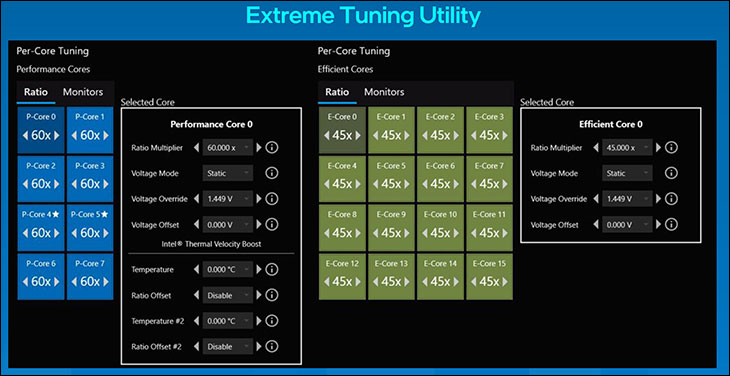
To be blunt. This is Intel doing what they do best – making cutting edge tech that is as easy as possible to use… and unlike Rob Zombie, the results point towards an even brighter future. This is both a good thing and a bad thing. It is good for the average consumer who want it to ‘just work’ (to the best of its abilities out of the box). Sadly, for enthusiasts Intel has done all the hard work for us. It is to the point where overclocking improvements are going to be minor (and let’s face it, just like you cannot turn a 16 core in a 24-core processor, you cannot turn a 24 into a 32 via overclocking). Even the “complexity” of overclocking two different core types at the same time is now pretty much a non-event. Intel make things so simple… so bloody easy that even a novice can do it.
For example, even just a few months ago the very idea of having even just two cores running at 5.8Ghz would have raised eyebrows and questions about what overclock you had applied to get it (and cooling you were running). Yet, that is now what the core i9 does ‘out of the box’. The same is true for its default ‘all core’ settings. 5.4+4.3 is no joke. That is a ton of power. However, if one simply downloads Intel’s latest version of Intel Extreme Tuning Utility the layout allows for extremely customized overclocking results… and even includes an ‘easy mode’. Everything from setting a favorite core to higher than the other cores, to separate P and E “all” core settings, to even customized P core frequencies and separate E-cores (or even P only, and E only overclocking). It is all there in a layout and format that most will instantly ‘get’ and thus no one can mess up… too badly.
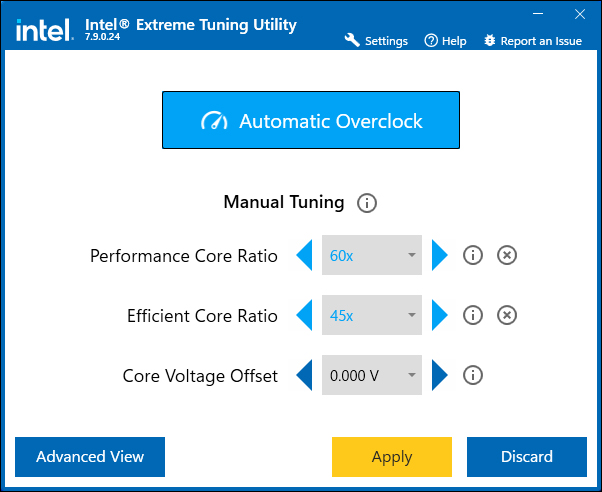
For a lark we set the i9 to all p-core overclock of 6Ghz, with an all e-core overclock of 4.5, set the voltage to 1.400v… and then pressed save. A simple reboot later… and we were done. No need to enter the BIOS. No need to refine things to a razors edge to keep it from crashing. Just… done. Everything worked, temperatures were better than the last gen at 5.5Ghz, and the system just… worked. Quite honestly, this is the first time in many years we looked at the rest of the local team and went “you know what… that’s good enough. We doubt anyone will want/need to push things higher than 6 Gig”… and then we let out a (very) manly giggle.
Easiest ‘overclock’ ever. Seriously.
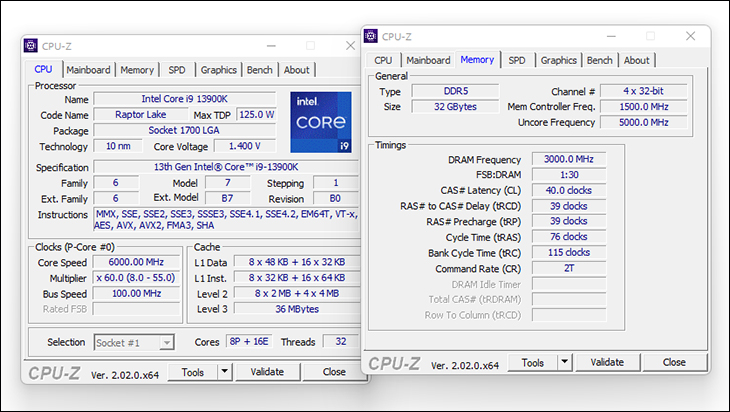
Of course, Intel XTU doesn’t really ‘do’ (or even get the reason for why you would want to do) memory overclocking. So we did go back and set things to stock, then unistalled Intel’s ETU… before doing the same via the BIOS. The only thing we did differently was set our DDR5-5600 to DDR5-6000 with a simple increase of 0.05v to the vdd/vddq ram voltage, and the IMC voltage; and changed LLC to be more aggressive. Bam. Truly done…ish.

Out of curiosity (and not for official testing purposes) we grabbed four 16GB sticks and tried our luck. In the last generation four sticks of moderately large DDR5 RAM was… touch and go. Some worked. Some did not. Usually, we recommended 2 sticks of 32GB over 4 x 16GB configurations as that was a lot less hassle and error prone. Using Micron based sticks it was a few clicks in the BIOS and bam. Instant “overclock” of DDR5-5200. Using DDR5-4800 rated kits (Micron 32GB CL40 nekkid kits to be precise). Color us impressed… as these are not SK HYNIX based, but ultra conservative Micron based kits. Kits known for less than excellent ‘overclocking’ abilities. Kits that now ‘just work’ at DDR5-5200.
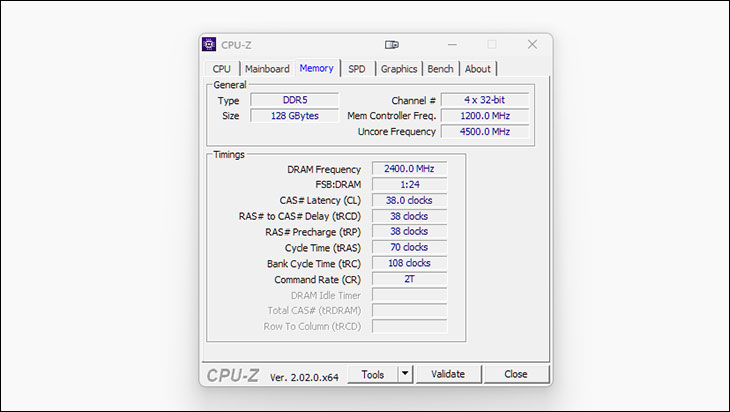
With such success, and out of shear morbid curiosity, we tried 128GB (two kits of 2x32GB DDR5-4800 CL40 Micron based sticks). With DDR5 2DPC 2R configurations the 12th gen was… less than stellar. It was finicky and each system we did it with took a bit of TLC (and ended up at different memory frequencies/timings). Which was a bloody shame as sixteen cores really need more than 64GB of RAM. With the 13th gen we got their XMP profile DDR5-4800 CL40 ratings with just the above voltage tweaks (and manually setting the timings). No fuss. No muss. It was so easy we spent five minutes tweaking to get CL38 to be stable. Of course, with a CPU sample size of two, and using an excellent motherboard, we cannot guarantee your IMC will allow for as good (or even better) 2DPC 2R results. But it is possible. It is even possible with only a few moments work.
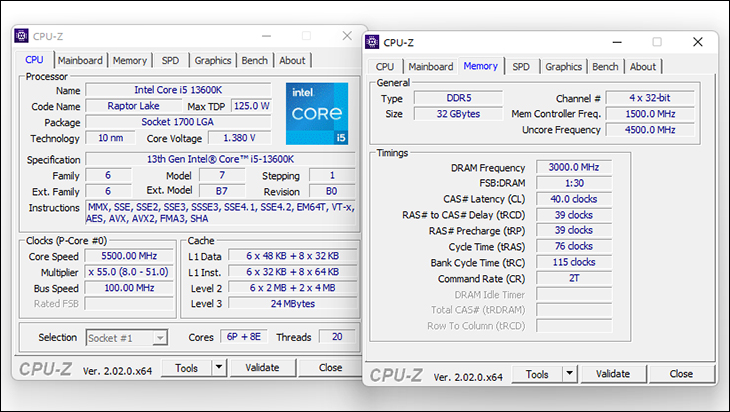
The exact same ease of use phenomena happened when we tested the core i5-13600K. Enter the BIOS. Set our official 2 sticks of ram (“1DPC 1R”) to what we know they can do above their rated specifications, set the P cores to 5.5GHz, the e-cores to 4.3GHz (aka better than a 12900KS with just two less p-cores), increase voltage to 1.380v, save, reboot. Done. Go grab a beer and start testing with overclocking.










